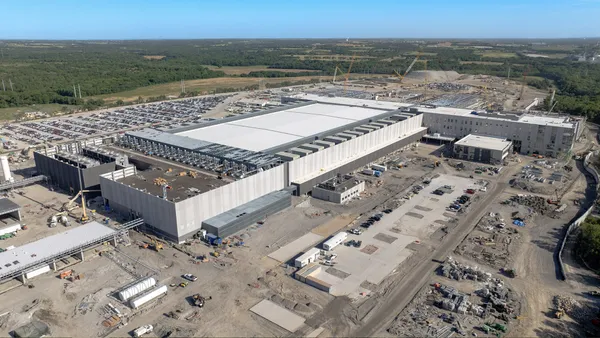The future has arrived. Robots, once the fodder of sci-fi movies and futuristic novels, now are working alongside humans to augment and, at times, replace them. Manufacturing has been increasingly more automated for years, but it’s only more recently that construction applied to its jobsites the computer engineering of robotics. QY Research Inc. valued the global construction robotics market at $200 million in 2017 and found that projects to which it applies will be valued at $420 million by the end of 2025 with a 10% compound annual growth rate from 2018 to 2025.
Construction Robotics President and Co-founder Scott Peters said his firm has stepped into the arena and made a name for itself by finding repetitive tasks it can automate using a robot. That tactic is working, as evidenced by the popularity of its Semi-Automated Mason (SAM) machine, as well as its Material Unit Lift Enhancer (MULE), which takes on the weight of a large block while still leaving it in the hands of a worker who can maneuver and place it. The MULE, in fact, illustrates Peters and his company’s recognition that humans have unique expertise and problem-solving skills and that robots should augment those capabilities to see the most productivity gains on jobsites.
When it comes to announcements of prototypes and research being done in the field of robotics for the construction industry, it’s easy to short circuit, so Construction Dive has put together a short list of some of the technologies already making a difference on jobsites, along with several robots in development that could be working alongside humans in the not-too-distant future.
Semi-automated mason
In addition to its MULE, Construction Robotics has made a big splash with its semi-automated mason (SAM) robot. Using a metal robotic arm to spread mortar on bricks before a laser-guided system lays the bricks in rows, the robot is designed to work on large, uninterrupted walls. Humans still must brick and mortar the first 5 feet of any area, in addition to corners and around windows and doors. On average, a mason can lay about 250 bricks per day. Compare that to the SAM, which can install 200 to 250 bricks per hour.
It already is making demonstrable differences on jobsites throughout the country. Take the $35.5 million University Arts Building at the University of Nevada, Reno. The SAM100 reportedly is laying about 60,000 of the three-story building’s total 100,000 bricks.
Across the country, Hoar Construction used the robot to help complete a 14-story federal project in Roanoke, Virginia. SAM installed 250,000 bricks — or about 70% of the project’s total. Bill Lampkin told Construction Dive earlier this year that it laid about 3,000 bricks per day, representing SAM’s largest project to date.
Tybot
Advanced Construction Robotics is about to finish its fifth Tybot rebar-tying robot, an autonomous robot that ties rebar to form bridge decks. The machine, which at its widest point spans 145 feet, can be supervised by only one worker and can expand on a frame up to 140 feet across a bridge’s width. Crews need to carry, place and frame-in only 10% of the deck rebar before Tybot can take over. The company estimates Tybot could halve labor hours and reduce injuries workers incur while straddling rebar frames and performing the repetitive tying motion.
The robot is available for lease and the company already has six contracts in place, including in New Hampshire, North Carolina and Pennsylvania. Advanced Construction Robotics co-founder and president Stephen Muck told the Pittsburgh Post-Gazette the company is in talks with 50 other contractors and that 25 foreign companies have expressed interest.
Tybot brought home top honors in the inaugural AGC-Autodesk Innovation Awards this year.
Doxel
By merging artificial intelligence and LIDAR laser scanning technologies, tech startup Doxel has created an autonomous robot that can climb stairs and move along construction sites while scanning site progress in 3D to help monitor project quality and schedule. Kaiser Permanente used the bot, which Doxel says helped it reduce its construction budget by 11% while increasing productivity by 38%.
Doxel’s website explains that AI “measures installed quantities and calculates earned value for thousands of line items, telling you exactly how much you owe for a day’s work.” It also creates real-time progress reports, measured production rates and project completion forecasts.
Plus, robots creating buzz that may be coming to a site near you:
BrickBot
A research project from the Autodesk Robotics Lab, Autodesk’s BrickBot uses computer vision and machine learning to enable a robot to infer what is going on its environment then adapt on the fly to accomplish an assigned task. Using robotic arms outfitted with cameras and sensors, the robot now can manipulate toy bricks, but researchers anticipate it will move on to real-world applications in the construction and manufacturing industries.
HRP-5P humanoid bot
Still just in the prototype phase, this bot, created by researchers at Japan’s Advanced Industrial Science and Technology Institute, combines environmental detection, object recognition and careful movement planning to install drywall independently. Numerous joints in the bot flex to degrees people are unable to, it can correct for slips and has fields of view beyond that of a human worker’s.
SpotMini robot dog
Boston Dynamics’ SpotMini robot dog stands less than 3 feet tall and is equipped with 3D vision and 17 joints, both of which help it navigate obstacles on a jobsite. The all-electric robot can survey a project via its onboard camera and pick up and handle objects with its perception sensors and an arm with five degrees of freedom. The engineering and robotics design firm is on track to produce 1,000 of these robot dogs per year by the end of 2019.



















